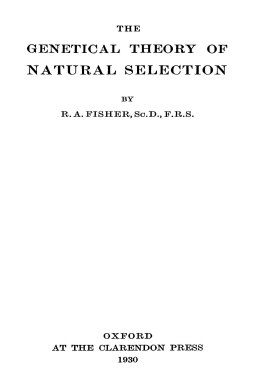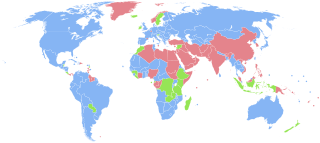Related Research Articles

Natural selection is the differential survival and reproduction of individuals due to differences in phenotype. It is a key mechanism of evolution, the change in the heritable traits characteristic of a population over generations. Charles Darwin popularised the term "natural selection", contrasting it with artificial selection, which is intentional, whereas natural selection is not.

Sexual selection is a mode of natural selection in which members of one biological sex choose mates of the other sex to mate with, and compete with members of the same sex for access to members of the opposite sex. These two forms of selection mean that some individuals have greater reproductive success than others within a population, for example because they are more attractive or prefer more attractive partners to produce offspring. Successful males benefit from frequent mating and monopolizing access to one or more fertile females. Females can maximise the return on the energy they invest in reproduction by selecting and mating with the best males.

A secondary sex characteristic is a physical characteristic of an organism that is related to or derived from its sex, but not directly part of its reproductive system. In humans, these characteristics typically start to appear during puberty. In animals, they can start to appear at sexual maturity. In humans, secondary sex characteristics include enlarged breasts and widened hips of females, facial hair and Adam's apples on males, and pubic hair on both. In non-human animals, secondary sex characteristics include, for example, the manes of male lions, the bright facial and rump coloration of male mandrills, and horns in many goats and antelopes.

Behavioral ecology, also spelled behavioural ecology, is the study of the evolutionary basis for animal behavior due to ecological pressures. Behavioral ecology emerged from ethology after Niko Tinbergen outlined four questions to address when studying animal behaviors: What are the proximate causes, ontogeny, survival value, and phylogeny of a behavior?

The Genetical Theory of Natural Selection is a book by Ronald Fisher which combines Mendelian genetics with Charles Darwin's theory of natural selection, with Fisher being the first to argue that "Mendelism therefore validates Darwinism" and stating with regard to mutations that "The vast majority of large mutations are deleterious; small mutations are both far more frequent and more likely to be useful", thus refuting orthogenesis. First published in 1930 by The Clarendon Press, it is one of the most important books of the modern synthesis, and helped define population genetics. It is commonly cited in biology books, outlining many concepts that are still considered important such as Fisherian runaway, Fisher's principle, reproductive value, Fisher's fundamental theorem of natural selection, Fisher's geometric model, the sexy son hypothesis, mimicry and the evolution of dominance. It was dictated to his wife in the evenings as he worked at Rothamsted Research in the day.

A sex ratio is the ratio of males to females in a population. As explained by Fisher's principle, for evolutionary reasons this is typically about 1:1 in species which reproduce sexually. However, many species deviate from an even sex ratio, either periodically or permanently. Examples include parthenogenic species, periodically mating organisms such as aphids, some eusocial wasps, bees, ants, and termites.

Fisherian runaway or runaway selection is a sexual selection mechanism proposed by the mathematical biologist Ronald Fisher in the early 20th century, to account for the evolution of ostentatious male ornamentation by persistent, directional female choice. An example is the colourful and elaborate peacock plumage compared to the relatively subdued peahen plumage; the costly ornaments, notably the bird's extremely long tail, appear to be incompatible with natural selection. Fisherian runaway can be postulated to include sexually dimorphic phenotypic traits such as behavior expressed by a particular sex.

Reproductive success is an individual's production of offspring per breeding event or lifetime. This is not limited by the number of offspring produced by one individual, but also the reproductive success of these offspring themselves.
In biology, the idea of an unbeatable strategy was proposed by W.D. Hamilton in his 1967 paper on sex ratios in Science. In this paper Hamilton discusses sex ratios as strategies in a game, and cites Verner as using this language in his 1965 paper which "claims to show that, given factors causing fluctuations of the population's primary sex ratio, a 1:1 sex-ratio production proves the best overall genotypic strategy".

Parental investment, in evolutionary biology and evolutionary psychology, is any parental expenditure that benefits offspring. Parental investment may be performed by both males and females, females alone or males alone. Care can be provided at any stage of the offspring's life, from pre-natal to post-natal.
In evolutionary biology and evolutionary psychology, the Trivers–Willard hypothesis, formally proposed by Robert Trivers and Dan Willard in 1973, suggests that female mammals adjust the sex ratio of offspring in response to maternal condition, so as to maximize their reproductive success (fitness). For example, it may predict greater parental investment in males by parents in "good conditions" and greater investment in females by parents in "poor conditions". The reasoning for this prediction is as follows: Assume that parents have information on the sex of their offspring and can influence their survival differentially. While selection pressures exist to maintain a 1:1 sex ratio, evolution will favor local deviations from this if one sex has a likely greater reproductive payoff than is usual.
Sex allocation is the allocation of resources to male versus female reproduction in sexual species. Sex allocation theory tries to explain why many species produce equal number of males and females.

Mate choice is one of the primary mechanisms under which evolution can occur. It is characterized by a "selective response by animals to particular stimuli" which can be observed as behavior. In other words, before an animal engages with a potential mate, they first evaluate various aspects of that mate which are indicative of quality—such as the resources or phenotypes they have—and evaluate whether or not those particular trait(s) are somehow beneficial to them. The evaluation will then incur a response of some sort.

The sexy son hypothesis in evolutionary biology and sexual selection, proposed by Patrick J. Weatherhead and Raleigh J. Robertson of Queen's University in Kingston, Ontario in 1979, states that a female's ideal mate choice among potential mates is one whose genes will produce males with the best chance of reproductive success. This implies that other benefits the father can offer the mother or offspring are less relevant than they may appear, including his capacity as a parental caregiver, territory and any nuptial gifts. Fisher's principle means that the sex ratio is always near 1:1 between males and females, yet what matters most are her "sexy sons'" future breeding successes, more likely if they have a promiscuous father, in creating large numbers of offspring carrying copies of her genes. This sexual selection hypothesis has been researched in species such as the European pied flycatcher.

Parental care is a behavioural and evolutionary strategy adopted by some animals, involving a parental investment being made to the evolutionary fitness of offspring. Patterns of parental care are widespread and highly diverse across the animal kingdom. There is great variation in different animal groups in terms of how parents care for offspring, and the amount of resources invested by parents. For example, there may be considerable variation in the amount of care invested by each sex, where females may invest more in some species, males invest more in others, or investment may be shared equally. Numerous hypotheses have been proposed to describe this variation and patterns in parental care that exist between the sexes, as well as among species.
Bateman's principle, in evolutionary biology, is that in most species, variability in reproductive success is greater in males than in females. It was first proposed by Angus John Bateman (1919–1996), an English geneticist. Bateman suggested that, since males are capable of producing millions of sperm cells with little effort, while females invest much higher levels of energy in order to nurture a relatively small number of eggs, the female plays a significantly larger role in their offspring's reproductive success. Bateman's paradigm thus views females as the limiting factor of parental investment, over which males will compete in order to copulate successfully.

Eusociality evolved repeatedly in different orders of animals, notably termites and the Hymenoptera. This 'true sociality' in animals, in which sterile individuals work to further the reproductive success of others, is found in termites, ambrosia beetles, gall-dwelling aphids, thrips, marine sponge-dwelling shrimp, naked mole-rats, and many genera in the insect order Hymenoptera. The fact that eusociality has evolved so often in the Hymenoptera, but remains rare throughout the rest of the animal kingdom, has made its evolution a topic of debate among evolutionary biologists. Eusocial organisms at first appear to behave in stark contrast with simple interpretations of Darwinian evolution: passing on one's genes to the next generation, or fitness, is a central idea in evolutionary biology.
A biological ornament is a characteristic of an animal that appears to serve a decorative function rather than a utilitarian function. Many are secondary sexual characteristics, and others appear on young birds during the period when they are dependent on being fed by their parents. Ornaments are used in displays to attract mates, which may lead to the evolutionary process known as sexual selection. An animal may shake, lengthen, or spread out its ornament in order to get the attention of the opposite sex, which will in turn choose the most attractive one with which to mate. Ornaments are most often observed in males, and choosing an extravagantly ornamented male benefits females as the genes that produce the ornament will be passed on to her offspring, increasing their own reproductive fitness. As Ronald Fisher noted, the male offspring will inherit the ornament while the female offspring will inherit the preference for said ornament, which can lead to a positive feedback loop known as a Fisherian runaway. These structures serve as cues to animal sexual behaviour, that is, they are sensory signals that affect mating responses. Therefore, ornamental traits are often selected by mate choice.
The theoretical foundations of evolutionary psychology are the general and specific scientific theories that explain the ultimate origins of psychological traits in terms of evolution. These theories originated with Charles Darwin's work, including his speculations about the evolutionary origins of social instincts in humans. Modern evolutionary psychology, however, is possible only because of advances in evolutionary theory in the 20th century.
Evolutionary aesthetics refers to evolutionary psychology theories in which the basic aesthetic preferences of Homo sapiens are argued to have evolved in order to enhance survival and reproductive success.
References
- 1 2 3 Edwards, A.W.F. (1998). "Natural selection and the sex ratio: Fisher's sources". American Naturalist. 151 (6): 564–569. doi:10.1086/286141. PMID 18811377. S2CID 40540426.
- 1 2 3 4 Fisher, R.A. (1930). "Chapter 6: Sexual Reproduction and Sexual Selection § Natural Selection and the sex-ratio". The Genetical Theory of Natural Selection. Oxford, UK: Clarendon Press. p. 141.
- 1 2 3 Hamilton, W.D. (1967). "Extraordinary sex ratios". Science. 156 (3774): 477–488. Bibcode:1967Sci...156..477H. doi:10.1126/science.156.3774.477. PMID 6021675.
- ↑ Charnov, E., and Bull, J. (1989). "Non-fisherian sex ratios with sex change and environmental sex determination", Nature 338, pp. 148–150. https://doi.org/10.1038/338148a0 Retrieved 29 March 2022.
- 1 2 Maynard Smith, J.; Price, G.R. (1973). "The logic of animal conflict". Nature. 246 (5427): 15–18. Bibcode:1973Natur.246...15S. doi:10.1038/246015a0. S2CID 4224989.
- ↑ Bull, J.J.; Charnov, E.L. (1988). "How fundamental are Fisherian sex ratios?". In Harvey, P.H.; Partridge, L. (eds.). Oxford Surveys on Evolutionary Biology. Vol. 5. Oxford, UK: Oxford University Press. pp. 96–135.
- ↑ MacArthur, R.H. (1965). Waterman, T.; Horowitz, H. (eds.). Theoretical and Mathematical Biology. New York, NY: Blaisdell.
- ↑ Nesse, Randolph M. (2019). Good Reasons for Bad Feelings: Insights from the Frontier of Evolutionary Psychiatry. Dutton. pp. 164–166. ISBN 978-1101985663.
- 1 2 Edwards, A.W.F. (2000). "Carl Düsing (1884) on the Regulation of the Sex-Ratio". Theoretical Population Biology. 58 (3): 255–257. doi:10.1006/tpbi.2000.1482. PMID 11120652.
- ↑ Shaw, R.F.; Mohler, J.D. (1953). "The selective significance of the sex ratio". American Naturalist. 87 (837): 337–342. doi:10.1086/281794. JSTOR 2458523. S2CID 85283716.
- ↑ Sober, E. (2011). Did Darwin Write the Origin Backwards? Philosophical Essays on Darwin's Theory. Amherst, NY: Prometheus Books.